Transpac 2019: How the race was won
Published on July 30th, 2019
Frederic Laffitte, President of marine supplier PYI Inc in the Pacific Northwest, shares how his team topped a fleet of 90 starters to win the 50th edition of the 2225 nm race from Los Angeles to Honolulu.
Being the strategist on the overall winner for Transpac 2019, the J/125 Hamachi, a 20 year boat with speed to burn, was a treat but involved a lot of prep work that at the end was all worth it.
We did not start this biennial race with the ambition to win it all but to at least beat the three other J/125s entered. Even if we did not have new sails (the youngest one was 4 years old), we did our homework and prepared the boat as well as could be.
Boat prep:
• We went over all the mechanical and electronic systems.
• Had brand new halyards and sheets made, taking special care regarding spin halyard chafe guards.
• Went through any possible water ingress areas, plugged every holes, taped every seam in order to have a proper water management. The J/125 is a low freeboard, fast boat which results in a very wet ride at any wind over 15 knots, including downwind.
• Tested all the sails and documented all the leads so there was no fumbling around after a sail change.
• Found a location in the boat for every single item, in order to keep the mess to a minimum.
• Serviced the rudder bearings.
Weather and routing prep:
• Followed the weather evolution from two weeks prior the start.
• Watched and studied Stan Honey’s briefing (see video).
• During the race we conferred and discussed weather and routing endlessly.
Morning of the race:
• After watching the latest weather we chose our sail selection for the race. This is always a tough one as we had to weigh the potential of a given sail versus its weight across the length of the race. We got lucky this trip and had on hand all the sails we needed, yet we did not carry any extra.
• Worked out where we wanted to be on the race course for the first 300 miles or so.
The race:
• We started in clean air and were lucky enough to almost clear the West End of Catalina Island in one shot. Our start (second of the three staggered starts) was lucky in that we had decent breeze right away unlike the earlier or later starters.
• Our first goal was to get to the real breeze (synoptic wind) as soon as possible, regardless of bearing or angle before dark.
• Once in the wind we decided to stay north of most of our fleet, sailing under J1 and Staysail and only on day 2 did we decide to fly the code zero and accelerate south.
• We had to stay south for the first 2 or 3 days as the remnants of a very South high pressure threatened a Northern route.
• Late on day 2 we had the spinnaker up and started sailing the boat to its maximum speed potential, even if that meant sailing high. A few degrees up on the J /125 made the difference between sailing 12 knots in 18 knots of breeze or sailing 16 knots in the same breeze. Looking back that late second day and all the third day is where we made most of our gains in our fleet. It seemed that for a time we had another gear.
• Day three is when we learned that we were leading race overall, on board we realized that not only we could beat the other 125s but we could win it all. We became very aware of our speed and made a 24/7 effort to sail the boat to its maximum potential….. for the next 5 days. We gave it our all.
• Days 4, 5, 6, and 7 were days of back and forth with the three J/125 on our tail and the very well sailed Rogers 46 Bretwalda in front. We were in a tough position as we tried to take a middle track between these two threats.
• One item that I want to emphasize is the fact that in order to keep the boat at 100% the helmsman must be 100%, and the particularity of our crew this race is that no one had to tell the helmsman that he was not performing; it was simply “guys I am not on it…. someone else steer.” Everyone owned it without hesitation.
Last 36 hours:
• The J/125 Velvet Hammer was nipping at our stern; they were sailing as good or better than us at this time and were able to gain a Northern leverage which threatened our position ( we owed them 1 ½ hour corrected). At the same time in front, Bretwalda was stretching their lead sailing very fast and to the South of us (they owed us 14 hours or us corrected).
• We jibed on every shifts, sometime less than 15 minutes in order to cover our position on the Hammer, but each time on starboard tack we would quickly lose time on them and Bretwalda so it became a matter of how much are we willing to lose in order to minimize the threat of the Hammer’s leverage. The wind was also lighter to make this agonizing sailing.
• The wind eventually filled in, somehow we picked the shifts correctly and we finished with enough time on both boats to win overall. Sailing the Molokai channel at 20 knots of boat speed, knowing we were winning the race was an amazing feeling, and we all took turns at the wheel with a grin on our faces.
Epilogue:
As stated before, we did not start this race with the dream to win it, yet when it mattered we were able to put together. The party thrown by our hosts Shawn and Marla O. Kelly at the Waikiki Yacht Club was fantastic (even if we finished at 2 AM) and for Hamachi’s owners, Shawn Daugherty and Jason Andrews, it was a memorable first Transpac that they are not about to forget.
Hamachi – Seattle, WA
Jason Andrews – Co-Owner – Group 1
Shawn Dougherty – Co-Owner – Group 1
Frederic Laffitte – Strategist- Group 1
Lucas Laffitte – Bow- Group 1
Matt Pistay – Cooler Jockey – Group 3
David Rogers – Navigator- Group 1
Division Winners:
Multihulls 0: Argo – MOD70 – Jason Carroll
Multihulls 0A: Kastor Pollux – 43-foot catamaran – Jerzy Poprawski
Division 1: BadPak – Pac52 – Tom Holthus
Division 2: Taxi Dancer – R/P 70 – Jim Yabsley / Mary Compton
Division 3: Hamachi – J/125 – Shawn Dougherty / Jason Andrews
Santa Cruz 50/52: Oaxaca – Santa Cruz 50 – Michael Moradzadeh
Division 5: Good Call – Swan 60 – Tom Barker
Division 6: BlueFlash – J/121 – Scott Grealish
Division 7: Chubasco – S&S Yawl 67 – Akin / Baker / Carpenter / Durant
Division 8: Sweet Okole – Farr 36 – Dean Treadway
Division 9: Nadelos – Wasa 55 – Ian Ferguson
Cal 40: Callisto – Eddy Family
Overall: Hamachi – J/125 – Shawn Dougherty / Jason Andrews
Overall Corinthian: Reinrag2 – J/125 – Thomas Garnier
Event Details – Entry list – Tracker – Results – Facebook
Note: There was a 4-hour delay on the tracker but goes live within the final 200 miles.
Attrition list:
• Mayhem, Hobie 33, Steven Eder (rudder)
• Aloha, Hobie 33, Kyle Vanderspek (rudder)
• Nalu V, Cal 40, Mark Ashmore (unknown water ingress)
• Trouble, Santa Cruz 50, Tom Camp (rudder)
• Live Wire, Olson 40, Tim Jones (mast damage)
• OEX, Santa Cruz 70, John Sangmeister (rudder – sunk)
• Pyewacket, Andrews 70, Roy Disney (rescued OEX)
• Macondo, Beneteau First 47.7, Mike Sudo (rudder)
• Onde Amo, Beneteau First 40.7, Stephen Ashley (rudder)
Background: First organized by the Transpacific Yacht Club in 1906, the biennial Transpacific Yacht Race or Transpac is an offshore sailing race from Point Fermin in Los Angeles to Diamond Head, just east of Honolulu, a distance of 2225 nm. The 2019 edition has 12 divisions with staggered starts on July 10, 12, and 13.
Boats racing in Divisions 6, 7, 8, 9, the Cal 40s, and the Multihulls in Class 0A started on July 10. The second start on July 12 was for the boats in Divisions 3, 5 and the Santa Cruz 50/52s, with the final start on July 13 for the remaining monohull entries in Divisions 1 and 2, along with the Multihull class 0 entries.
The current race records were set in 2017 when Comanche set the new Merlin trophy elapsed time record at 5 days 01:55:26. Comanche also set a 24 hour distance Transpac record at 484.1 nm, a 20.2 knot average speed. The ORMA 60 trimaran Mighty Merloe set the multihull elapsed time record at 4 days 06:32:30.


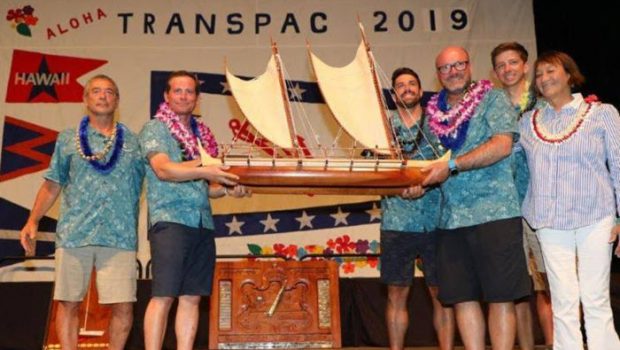


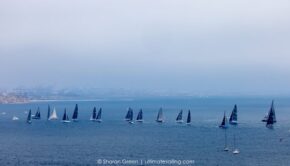
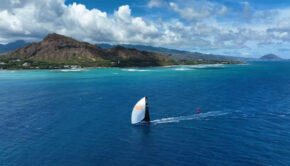
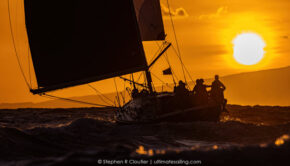
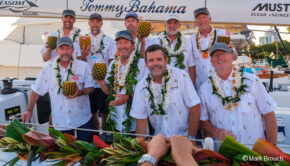
 We’ll keep your information safe.
We’ll keep your information safe.